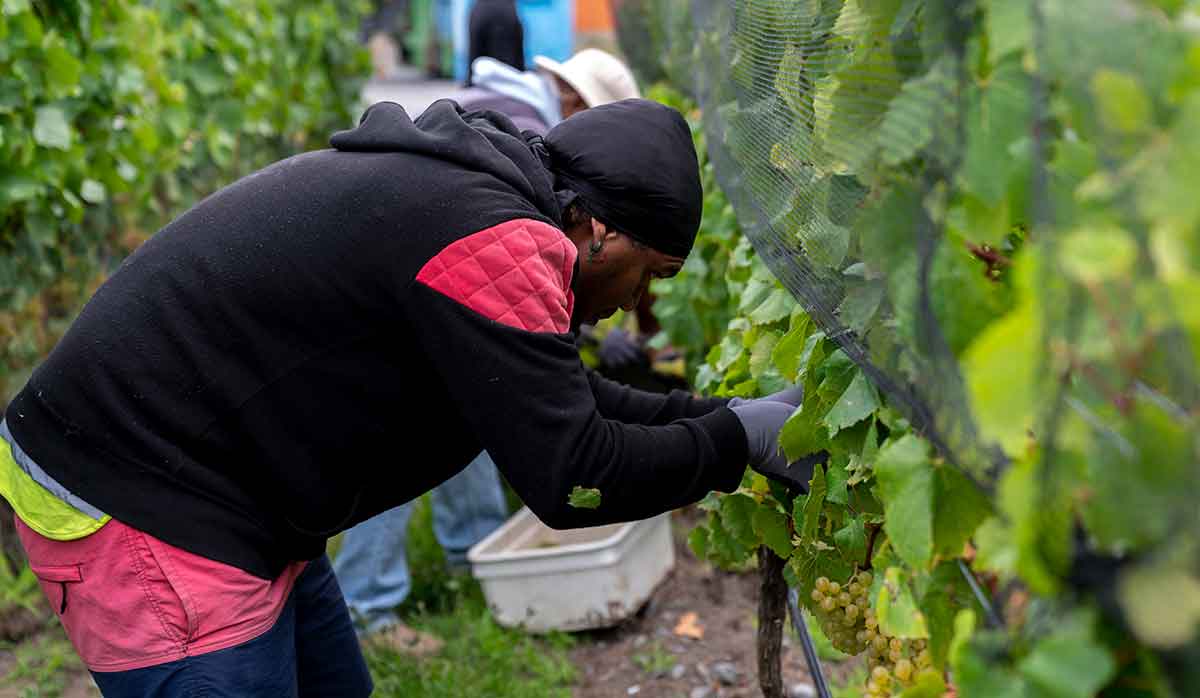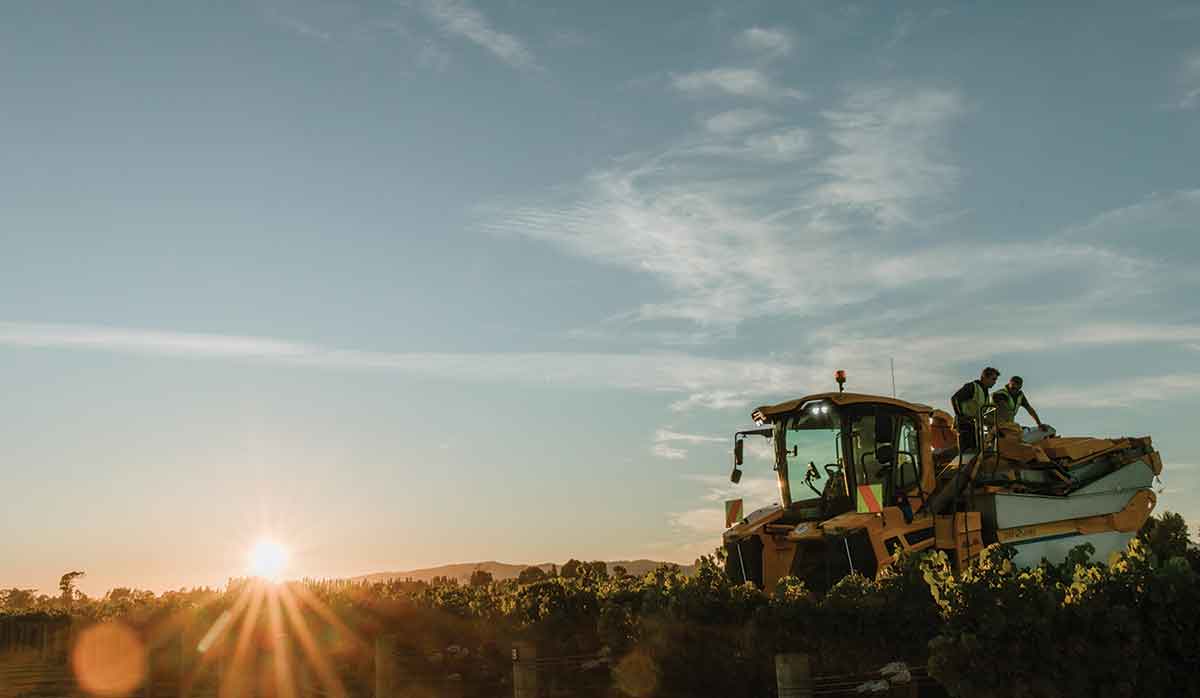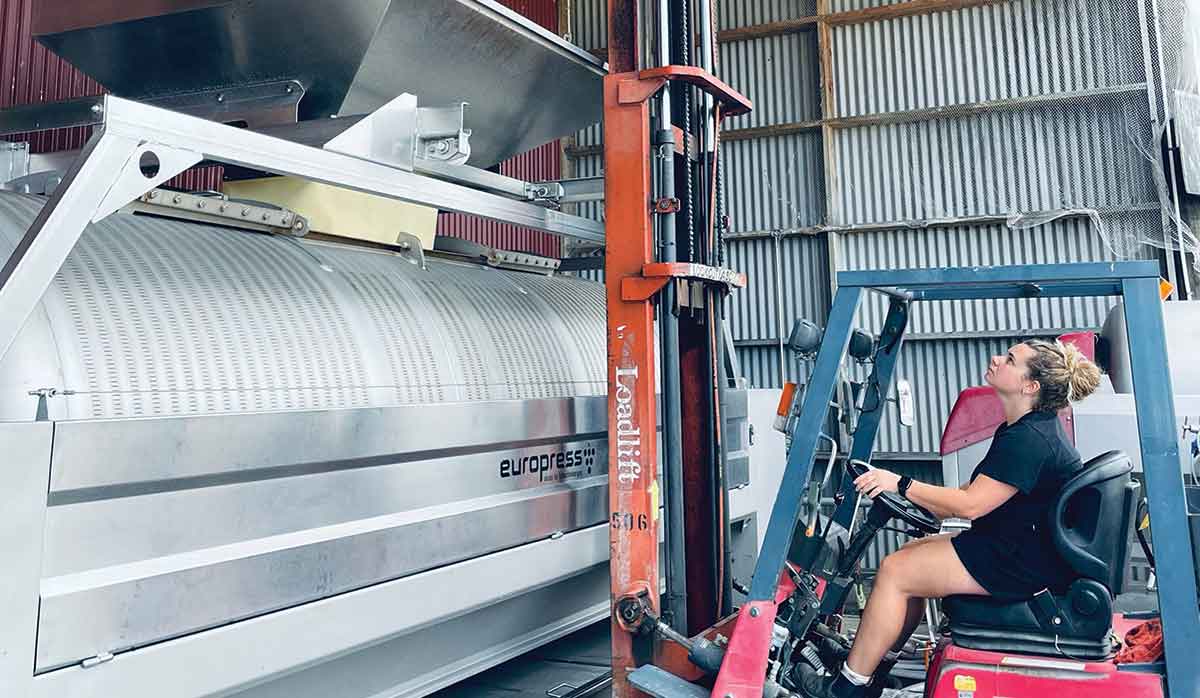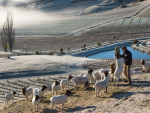The Landing: Destination wine tourism with soul
At The Landing in Northland, destination wine tourism is integrated into a carefully balanced whole.
Nature has little regard for supply and demand equations, and there were abundant, high-quality crops for many around the country this harves. While the industry grapples with slowing markets, excess supply and uncertainty around trade barriers, Sophie Preece hears that vintage 2025 kicked off with perfect parcels of delicious fruit.
Northland
Northland growers welcomed hot dry conditions in the lead up to vintage, with the season nearing completion in mid-March. A January rain-dump washed through with little impact, and was followed by optimum growing conditions, says Peter Jones of The Landing, who is also Chair of the Northern Winegrowers Association. "We have been able to pick as we have wanted to, rather than being forced into it by weather". The past few vintages have been struck with inclement conditions, and vines affected by 2023's Cyclone Gabrielle were still recovering in the 2024 vintage, says Pete, delighted to reflect on this year's excellent season.
Auckland
Auckland winegrowers enjoyed the driest season since 1958, leading to a high-quality harvest of good yields, says Michael Brajkovich of Kumeu River Wines. 1974 was hotter and drier than 2025, with this season's temperatures a moderate 25C to 26C, and only one day at 28C, "so very good growing conditions", he says. The season was "significantly earlier" than normal, with Auckland's harvest finished by 7 March. And it's carried "outstanding fruit", Michael says. Chardonnay is the standout variety, with good sugar levels, and very good flavour. "Acidity is a little bit lower than usual, but still nice and bright."
Waiheke Island
Barnett Bond has been growing grapes on Waiheke Island for 32 years, "and I cannot remember a more perfect growing season, from the result", he says in mid-March. "Basically, we've had California since Christmas, every single day. Blue skies, no clouds and no wind." Big winds "blowing nonstop" in the lead up to Christmas gave some growers a scare, impacting development of hilltop vines, says Barnett. But the beautiful weather that followed has more than made up for that bluster. "I think most Waiheke grape growers would be extremely pleased with the season from a point of view of ease of viticultural management, low disease pressure, and getting grapes perfectly ripe at the end of the season. That of course makes the winemakers extremely happy too."
Gisborne
Gisborne growers also started harvest early, with Millton Vineyards picking about 10 days ahead of usual, kicking off in the first week of March. Annie Millton says rain between Christmas and New Year put some pressure on things, followed by "flicks" of southerlies throughout January. However, the grapes overall are looking good, thanks to the even conditions that followed. Yields are “great”, with good flowering and good set on all varieties, requiring plenty of fruit thinning on very heavy crops, she says. “And Chenin in particular. We thinned that twice.” A highlight this season has been “beautiful” Chardonnay fruit from a hillside exposed to good sunlight, she says. “It was a beautiful golden colour, with nice pH and nice sugar levels. Just perfect.” Speaking on 17 March, Annie says if the weather is kind (despite forecasts of a potential southerly shift) she expects to finish around the end of March.
Wairarapa
“Brilliant,” says Oraterra Winemaker Wilco Lam of the 2025 vintage. Speaking on a cool and rainy 19 March, the Wairarapa Winegrowers Association Chair says everyone he has spoken to in the region is cranking through harvest quickly, with fruit in excellent condition. The rain is a slight setback, but at 12C it’s unlikely to impact fruit, given its state of health. “It will get through it pretty well,” he says. A beautiful flowering period gave the region good yields, and cool January conditions, followed by moderate warm days (“nothing crazy warm”), have resulted in “exceptional” Chardonnays and “juicy” bunches of Pinot Noir, tending to floral, pretty wines with uplifted aromatics. “It’s a pretty classic sort of Pinot year really.” With Pinot crops up by about 20%, and other varieties fruitful as well, wineries are looking full across the board, Wilco says. “Not many people have empty space left; it’s a jam-packed year.”
Hawke's Bay
Craggy Range started its harvest a week earlier than ever before, with Chardonnay picking crews out from 8 February. Chief Winemaker Ben Tombs says there was an excellent and early flowering, setting good crop levels, followed by a very cool summer, without the high temperatures the region is used to. Canopies and flavour development “charged on” nonetheless, and the moderate temperatures and cool nights resulted in great acidity in Chardonnay, along with moderate alcohol. Speaking on 17 March, Ben says Craggy Range has just started on its Merlot harvest for Bordeaux blends, with Cabernet and Syrah a couple of weeks away. With good yields and high flavour concentration, morale is high within the team, he adds. “I’m really, really excited."
 |
|---|
|
Philimon Filimea was part of the Craggy Range Chardonnay hand pick in vintage 2025. Photo Credit Richard Brimer. |
Brent Linn of Wairiki Wines, who is Executive Officer of Hawke’s Bay Wine, says the region has been “absolutely blessed” in the run up to, and throughout, vintage 2025. The white varieties came in under “kind skies” with the benign weather looking to continue through the red harvest, he says on 18 March. “There is a lot of excitement amongst the Hawke’s Bay wine community of the potential of vintage 2025, from all of our subregions.” Like Ben, he is seeing balanced wines with “lovely acids and full brightness”, thanks to the lack of hot days. “It’s been ideal really for an orderly vintage.”
When it comes to market concerns, the region’s growers and wine companies are adaptable and will “pivot” to deal with challenges, Brent says. “What is really important is that we have full cellars and full tanks to meet the opportunities.”
Nelson
The Nelson harvest kicked off about a week behind “normal”, due to cooler January temperatures, says Chris Seifried of Seifried Estate. Speaking on 19 March, he says harvest of Chardonnay, Pinot Gris and Pinot Noir is well under way, while recent cool nights have further slowed ripening on Sauvignon Blanc. “But we are happy with how the crop is looking and will commence picking first Sauvignon Blanc blocks in the coming days.” The weather was “fantastic” during the first week of harvest, and a couple of small rain events on 18 and 19 March were blown through with strong winds “helping to dry out the canopy quickly”, Chris says, noting that the weather forecast looks good leading into April. “Quality is above expectations with lovely flavours, nice acidity and clean fruit.” Yields are slightly above average “but certainly not huge”, he adds. “We’re very happy with the harvest progress and quality that we’re seeing in vintage 2025.” This is the Seifried family’s 50th vintage, thanks to Hermann and Agnes Seifried pioneering wine production in the Nelson region in 1973, with their first vintage in 1976.
Marlborough
Marlborough has seen bumper flowering, potentially record-breaking yields, and a benign ripening season in the lead up to harvest 2025. With a decline in global wine demand and surplus wine in tanks and bottle, the industry has been busy managing inventory, yields and logistics.
Marlborough’s harvest started early and gently for Jules Taylor, with Pinot Gris, most of the Pinot Noir and all the hand pick Chardonnay in by 19 March, along with young blocks of first-crop Sauvignon Blanc. The winemaker then had to cool her heels before the Sauvignon onslaught. “The ‘go’ button has been pushed, but it’s been a very sedate and leisurely lead up.”
The region had excellent flowering and big yields this season, and despite judicious fruit thinning, Sauvignon blocks are taking time to ripen in cooler conditions, Jules says, expecting her Sauvignon harvest to ramp up the week of 24 March. “Last year everything was done and dusted in March because it was a lower crop and much warmer. We are just getting back to a more normal growing season this year.”
 |
|---|
|
Jules Taylor Wines 2025 Harvest. Photo Credit: Lisa Duncan. |
The cooler summer season allowed for good flavour development at relatively low sugars in the Pinot Gris, which was “lovely”, says the winemaker and founder of Jules Taylor Wines. She expects Sauvignon to follow suit, thanks to autumnal nights keeping acids fresh, while the longer hang time delivers flavour concentration.
Thirty-one years after her first vintage in the industry, and 25 years after she started her eponymous label, Jules still relishes the energy and excitement of the Sauvignon harvest. “It’s the one chance we get,” she says. “We work in an industry where there are so many different parts – the growers, then the harvest and the winery. It’s a big thing for our industry and I just frigging love it.”
Managing the intake each year requires an abundance of crystal ball gazing “and it’s super hard to get it right”, Jules says. “You don’t know what’s going to happen in the market… If anything we are just trying to manage growers’ expectations, our own expectations, the markets’ expectations, and hope that what we do is going to turn out ok, with the help of Mother Nature sprinkled in.”
So far so good for the brand, which has not felt too much of a slowdown. “It’s hard out there but we have worked really closely with our distributors to maintain our price point, spend time in the market, and visit the people who are buying our wine and sharing it with their customers,” she says. “We really try to stay connected.” After a Covid-19 hiatus, they got back into travel in 2023, which has been vital to maintaining and building sales. “It’s expensive, with the New Zealand dollar so weak against the United States… But I think it’s really important to stay in the face of those people who are selling your wines.” Making the wine is the easy bit, she says. “Getting someone to pour your wine rather than someone else’s, that’s hard, because there are so many wines to choose from.”
Nick Entwistle, Chief Winemaker at Rose Family Estate, says the biggest challenge in this impressive harvest could be finding space in wineries. By 20 March the family-owned company had been harvesting for a few weeks, with rosé, Chardonnay and Pinot Noir in, as well as some early blocks of Sauvignon Blanc. Nick has been happy with crop levels, but expects to see heavier loads as the harvest progresses down the valley.
A dry season meant fruit was in great condition in the lead up to rainfall on March 18 and 19, and disease risk was low leading into the Sauvignon push. Flavours are “really good” and brix of 21 to 21.5 are “bang on” for demand, “especially from the United Kingdom, where they want it lower in alcohol”, he says.
The industry at large has taken a “pragmatic approach” to the heavier yields in a troublesome market, with many cutting canes and dropping fruit. But big berries and heavy bunches, thanks to a great flowering and growing season, will put the squeeze on some when it comes to winery space.
Rose Family Estate is seeing strong demand in some key markets, and has sold most of its 2024 vintage. But a surge in people looking to clear out wineries in the lead up to harvest has reduced the availability of trucks and containers to get wine sent out, he says. That’s seen Rose Family Estate sending some wine on the train this season, which they haven’t done for a long time. “We’re cautiously positive,” he says. “Everything in the winery looks really good. But can we get some of that inventory out of the winery before we need the space?”
Going forward the wine industry needs be “out there shaking hands and building relationships”, Nick adds. “The key is to get people to taste the wine. You just have to fight for it a bit more.”
The season’s fruit looks “really promising,” says Sophie Parker-Thomson, a few days before Blank Canvas Wines started its harvest. “If this weather continues, we are in for a good one.” Sophie, who is Chair of Appellation Marlborough Wine (AMW) says many of the group’s members, operating at a higher end of the market, are less impacted by the market decline, if not fully insulated. “Everyone still has to be very careful to make sure you are making what you can sell, especially with time-sensitive varieties like Sauvignon Blanc.” However, a $30 bottle of Sauvignon is in a different segment from the “commodity-type business model”, including the bulk wine market, she says. “That’s where the real pain is happening.”
Blank Canvas is diverting more fruit than usual to their higher end wines to respond to the market, including their Abstract barrel fermented Sauvignon, while also maintaining the Holdaway Sauvignon Blanc as a “gateway” to their more expensive wines. Speaking on 14 March, Sophie notes the “abundance” of crop in Marlborough vineyards, having talked to growers with yields 20% above their estimates, as well as those with no contracts at all, left in the lurch as supply outstrips demand. “Every second day I have been contacted by people saying ‘do you need any more Pinot? Do you need any Chardonnay? Do you need any Sauvignon?”
Growing Pains
Grape Sense owner and viticultural consultant Mike Insley says 2022 and 2023 were good years from a grower perspective, but last year the grape price dropped from $2,400 to $2,100, yields were down, and costs continued to ramp up. This year some growers are facing tighter yield caps as well as a lower price, he says, estimating a likely district average of $1,800 per tonne of Marlborough Sauvignon Blanc. For others, the absence of a grape contract could see grapes unharvested this year, or sold for a “lowball” price. “It’s tough out there. And after the economic impact of last year, a lot of people are hurting.”
Growers without a contract have paid for their expenses in advance, so it’s a huge financial burden to see the income left on the vine or dropped to the vineyard floor. “Some of them may only just have bought the vineyard and may not have understood the importance of having a contract.” In some cases, wineries have terminated or not renewed their grower contracts, he says.
Wine Marlborough General Manager Marcus Pickens says there is a lot of concern in the industry, from some larger companies facing pressure in retail or the bulk wine market, to some boutique producers feeling the strain of lighter on premise demand, “but people are working hard to right the ship”. That will take time, he adds, noting that new vineyard developments are still coming into production while other blocks are being taken out. “You cannot supply
more than you can sell. The worst case would just to be marching merrily on, pretending it’s all going somewhere, as domestic and international consumption is not rising. We have to be acute in listening to the market.” That’s something New Zealand’s wine industry has always been “really good” at, Marcus says. “Listening to the market and supplying what it wants.”
North Canterbury
The weather has been a rollercoaster for North Canterbury growers this season, with a beautiful spring and excellent flowering, followed by the coldest January on record. By the start of harvest the region was back up at the long-term average in term of temperatures, says Greystone Winemaker Dom Maxwell on 20 March, “which these days feels cooler – we are just so used to having warmer seasons”.
They’ve also been beset by more rain than he’d like, with moisture through January and another 40mm on 18 and 19 March, “which is not what were after at this stage”. The rain came with southerly temperatures around 15C (two days after a 30C high) as well as plenty of wind, mitigating disease pressure in the damp.
 |
|---|
|
Georgia Mehlhopt, 2024 Tonnellerie de Mercurey Young Winemaker of the Year, at Greystone Wines, vintage 2025. |
Despite temperamental weather, the region has good yields of “really good” fruit, Dom says, particularly pleased with “amazing” parcels from rain-resilient hill blocks. “We had good flowering and for a lot of the smaller produces here, who have been battling small crops, it’s a welcome return to a good harvest.”
The rest of March would be focussed on the harvest of Pinot Noir and Chardonnay, “and we’re hoping for some sustained dry weather for the later varieties”, Dom says. When it comes to morale, North Canterbury is a region well-seasoned in resilience, often dealing with an oscillation of supply, he says. “We’ve always had this balance of do we have enough? Or do we have too much?” This year it looks just right. “To be honest we're happy. We need the fruit."
Central Otago
Central Otago’s wine industry has had “a season of two parts”, says viticulturist James Dicey of Grape Vision on 20 March. “The early part was dominated by very late, very deep frost, then by a generous warm period supplemented by regular and significant rainfall,” he says, welcoming a good recovery in vineyards, and remarkable canopy growth and flowering. There is more hen and chicken than normal, which he’s putting down to frost rather than flowering.
“The second part of the season has been punctuated by what feels like a warm season but looking at the data is an average season from a heat perspective, but is very, very dry,” James says, noting that Central Otago is normally a summer rainfall area. “We had 15mm of rain in Bannockburn a couple of days ago which is the first substantive rainfall since before Christmas.” That has put the region in a “very severe, very short-term drought”.
Harvest began around mid-March for sparkling and rosé, which is a week earlier than typical, says James. Beyond the two parts is a “surprising” and welcome anomaly, with a late surge in berry weights driving an unexpected increase in yields. With irrigation only maintaining vines, he doesn’t know why the surge is happening, but he’ll take the win, “and I’ll celebrate by dancing naked in the rain”. The boost means his earlier predictions that the regions would be 20 to 25% down in yields have been revised to less than 10% now.
However, some vines are showing the impact of the dry, and blocks with “parsimonious” watering have already “come a bit unstuck”, James says. A cold snap could result in vines shedding canopy, putting pressure on pick dates. Last year James lamented the drawn out nine-week harvest, due to a cool ripening period, instead of the normal five or six weeks, “but we might be complaining about four weeks this year”. A recent trip to Auckland buoyed his optimism in the demand for fine wines in high end on premise, which adds to his glass half full perspective. “If you are a famer, which is what we are, by nature you must be an optimist. Otherwise, this game gets on top of you.”
And he is “more than cautiously optimist” Central will end up with a good result this year. Putting his marketing hat on, “this is the vintage of the century, like every year... but realistically ask me in five years’ time when we have the proper time to reflect and consider what we have achieved”.
Waitaki
The season is shaping up to be “exceptional”, says Te Kano Winemaker Dave Sutton, who is Chair of Waitaki Winegrowers. Frosts in late spring affected some vineyards in the region, but the majority escaped significant damage. “Flowering was unusually fast and uniform, setting good yields of even bunches with beautiful architecture,” Dave says. “Weather through veraison and up to now has been relatively settled with warm days and very cool nights, and if the pattern continues we are looking at a season of excellent yield and quality.”

The end of the year is fast approaching, so here are some thoughts on a few of the significant developments…

OPINION: When I moved to Marlborough two decades ago, I found countless lines of tidy vines, neatly mowed and carefully…
The large 2025 harvest will exacerbate the wine industry's "lingering" supply from recent vintages, New Zealand Winegrowers Chief Executive Philip…
If you find a new consumer in a developed wine market, you are taking them from someone else, says Blank…
With the stars of Matariki to rise in June, Jeff Sinnott, a member of the Tuku Māori Winemakers Collective, looks at…